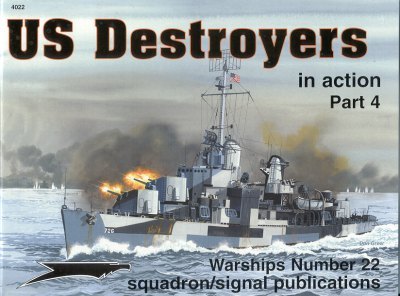 In
this fourth edition, two of the larger builds of US destroyers are covered;
that of the Sumner and Gearing classes. Both of these classes utilized the
twin 5 inch multi-purpose gun mounts for their main armament. They were
also developed from the Fletcher class so are in some ways, similar. The
Sumner class added nearly two feet to the beam of the Fletcher class to
accommodate the larger turrets. These ships were first commissioned in late
1943 and built in five different shipyards.
In
this fourth edition, two of the larger builds of US destroyers are covered;
that of the Sumner and Gearing classes. Both of these classes utilized the
twin 5 inch multi-purpose gun mounts for their main armament. They were
also developed from the Fletcher class so are in some ways, similar. The
Sumner class added nearly two feet to the beam of the Fletcher class to
accommodate the larger turrets. These ships were first commissioned in late
1943 and built in five different shipyards.
The later Gearing class was simply a Sumner with an
additional section added in between the two stacks so that additional fuel
could be carried, extending its unrefueled range. Only a handful of Gearing
ships were able to see action in WWII, the majority completed post war with
the last commissioned in the early 1950s.
Many of the Sumner ships were converted to fast mine
sweepers, but with the changing war, none ever laid a single mine! Both
classes were converted into other types of ship including radar picket and
fleet escorts. Several underwent modification in the late 1950s to carry
the QH-50 DASH anti-submarine drone helo. They were also used as the first
missile destroyers, carrying Tartar missiles.
As with many US destroyers, after they had served their
time in the USN, they were sold off to countries friendly to the US in the
early 1970s. Most have since been decommissioned, but a few are still in
active service with their respective navies.
Typical of the In Action series, there is a decent
historical background, but it is photographs that make up the bulk of the
book. The entire first half of the book is on the Sumner class with the
second half devoted to the Gearing and the various modifications and
conversions made to the ships.
Camouflage is as important to ship builders as it is to
aircraft modelers and that is also well documented in this book. Included
is an FS 595 equivalency chart to help modelers with the various colors. As usual,
there are excellent profiles in the center that give a good representation
of these camouflage schemes.
As with the others in the series, it is a really fascinating book, especially for those of
us who are nautically challenged, and an excellent general reference on the
types portrayed.
You can find this book and many others at

If you would like your product reviewed fairly and quickly by a
site that has over 250,000 visitors a month, please contact
me or see other details in the Note to
Contributors.
 In
this fourth edition, two of the larger builds of US destroyers are covered;
that of the Sumner and Gearing classes. Both of these classes utilized the
twin 5 inch multi-purpose gun mounts for their main armament. They were
also developed from the Fletcher class so are in some ways, similar. The
Sumner class added nearly two feet to the beam of the Fletcher class to
accommodate the larger turrets. These ships were first commissioned in late
1943 and built in five different shipyards.
In
this fourth edition, two of the larger builds of US destroyers are covered;
that of the Sumner and Gearing classes. Both of these classes utilized the
twin 5 inch multi-purpose gun mounts for their main armament. They were
also developed from the Fletcher class so are in some ways, similar. The
Sumner class added nearly two feet to the beam of the Fletcher class to
accommodate the larger turrets. These ships were first commissioned in late
1943 and built in five different shipyards.